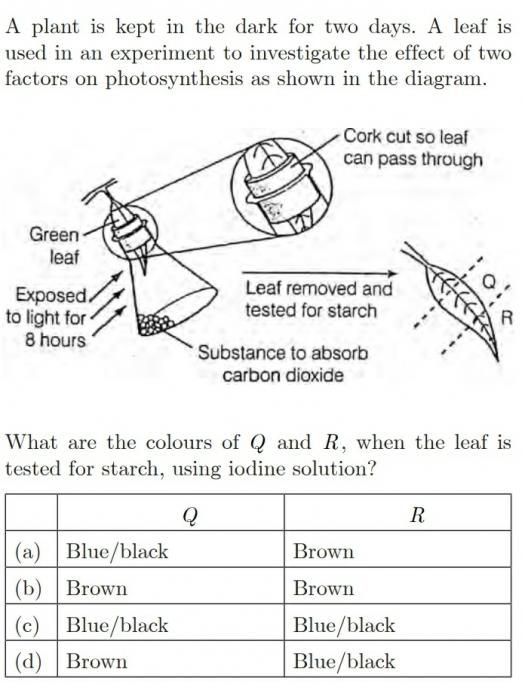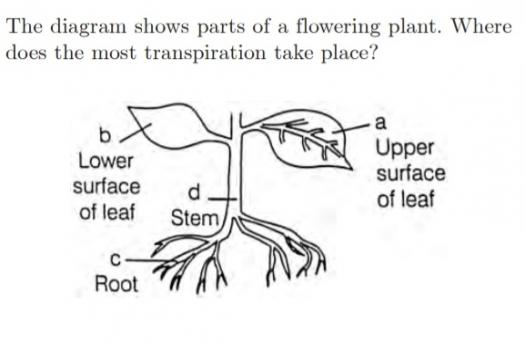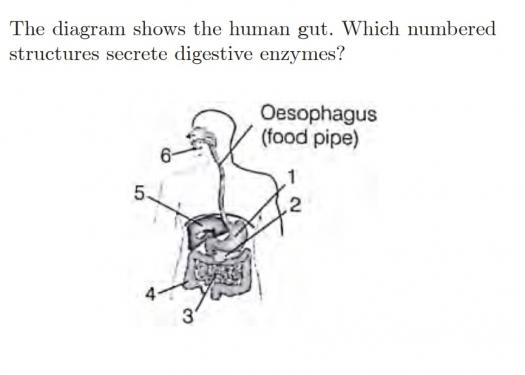Biology Test - Life Processes

This BIOLOGY TEST - LIFE PROCESSES assesses knowledge on key biological processes such as anaerobic respiration in plants, the breakdown of pyruvate, and protein digestion. It emphasizes understanding of cellular functions and physiological mechanisms in organisms.
- 1.
OPTION 1: ASSERTION & REASON ARE CORRECT, REASON IS THE CORRECT EXPLANATION. OPTION 2: ASSERTION & REASON ARE CORRECT, REASON IS NOT THE CORRECT EXPLANATION. OPTION 3: ASSERTION IS TRUE, REASON IS FALSE. OPTION 4: ASSERTION IS FALSE, REASON IS TRUE.
- 2.
What are the products obtained by anaerobic respiration in plants?
- A.
Lactic Acid + Energy
- B.
Carbon dioxide + water + energy
- C.
Ethanol + Carbon dioxide + Energy
- D.
Pyruvate
Correct Answer
C. Ethanol + Carbon dioxide + EnergyExplanation
During anaerobic respiration in plants, glucose is broken down into pyruvate through glycolysis. In the absence of oxygen, pyruvate is further converted into ethanol and carbon dioxide, releasing energy. This process is known as alcoholic fermentation. Therefore, the correct answer is "Ethanol + Carbon dioxide + Energy".Rate this question:
-
- 3.
The breakdown of Pyruvate takes place in:
- A.
Cytoplasm
- B.
Mitochondria
- C.
Nucleus
- D.
Chloroplast
Correct Answer
B. MitochondriaExplanation
The breakdown of pyruvate takes place in the mitochondria. Pyruvate is produced during glycolysis in the cytoplasm, but it needs to be transported into the mitochondria for further breakdown through a process called pyruvate oxidation. This process occurs in the mitochondrial matrix, where pyruvate is converted into acetyl-CoA. Acetyl-CoA then enters the citric acid cycle (also known as the Krebs cycle) within the mitochondria, where it is further broken down to release energy. Therefore, the correct answer is mitochondria.Rate this question:
-
- 4.
ASSERTION: ALL PROTEINS IN OUR FOOD IS DIGESTED IN SMALL INTESTINE ONLY. REASON: THE PROTEIN DIGESTING ENZYMES ARE RELEASED ONTO THE SMALL INTESTINE.
Correct Answer
OPTION 4, 4Explanation
Proteins in our food are digested in the small intestine because the protein-digesting enzymes are released onto the small intestine. This is true because the small intestine is the primary site of digestion and absorption in the digestive system. The enzymes responsible for protein digestion, such as pepsin and trypsin, are secreted by the pancreas and released into the small intestine. These enzymes break down proteins into smaller peptides and amino acids, which can then be absorbed by the intestinal lining and utilized by the body for various functions. Therefore, all proteins in our food are digested in the small intestine due to the release of protein-digesting enzymes in this organ.Rate this question:
- 5.
ASSERTION: DIGESTION BREAKS LARGE COMPLEX MOLECULES TO SIMPLER SMALLER MOLECULES WHICH CAN EASILY BE ABSORBED. REASON: DIGESTION IS NECESSARY FOR THE ABSORPTION OF ALL MOLECULES.
Correct Answer
OPTION 3, 3Explanation
Digestion breaks down large complex molecules into simpler smaller molecules that can easily be absorbed. This is necessary for the absorption of all molecules. The reason is that large complex molecules cannot be absorbed directly into the bloodstream, so they need to be broken down into smaller molecules that can be easily transported across the intestinal lining and into the bloodstream. Therefore, digestion is essential for the absorption of all molecules.Rate this question:
- 6.
ASSERTION: IN PLANTS, THERE IS NO NEED OF SPECIALISED RESPIRATORY ORGANS. REASON: PLANTS DO NOT HAVE GREAT DEMANDS OF GASEOUS EXCHANGE.
Correct Answer
OPTION 2, 2Explanation
Plants do not have a great demand for gaseous exchange because they have a slow metabolic rate and do not require a large amount of oxygen for respiration. Additionally, plants have specialized structures such as stomata, which are small openings on the surface of leaves, that allow for the exchange of gases with the environment. This eliminates the need for plants to have specialized respiratory organs like lungs or gills, which are found in animals. Therefore, the assertion that plants do not need specialized respiratory organs is supported by the reason that they do not have a high demand for gaseous exchange.Rate this question:
- 7.
WHAT HAPPENS WHILE A PERSON EXHALES?
- A.
DIAPHRAGM RELAXES AND MOVES UPWARDS, INTERCOASTAL MUSCLES CONTRACTS AND MOVES FORWARD
- B.
DIAPHRAGM CONTRACTS & MOVES DOWNWARDS, INTERCOASTAL MUSCLE CONTRACTS AND MOVES FORWARD
- C.
DIAPHRAGM RELAXES AND MOVES UPWARDS, INTERCOASTAL MUSCLES RELAXES AND MOVES BACK
- D.
DIAPHRAGM CONTRACTS AND MOVES UPWARDS, INTERCOASTAL MUSCLES CONTRACTS AND MOVES BACK TO ORIGINAL POSITION
Correct Answer
C. DIAPHRAGM RELAXES AND MOVES UPWARDS, INTERCOASTAL MUSCLES RELAXES AND MOVES BACKExplanation
During exhalation, the diaphragm, which is a dome-shaped muscle located at the bottom of the ribcage, relaxes and moves upwards. This relaxation allows the lungs to push air out of the body. At the same time, the intercostal muscles, which are located between the ribs, also relax and move back to their original position. This combined action of the diaphragm and intercostal muscles helps to decrease the volume of the chest cavity, increasing the pressure in the lungs and pushing air out.Rate this question:
-
- 8.
IN WHICH ORDER DO THE EVENTS OCCUR IN HUMAN NUTRITION?
- A.
DIGESTION - INGESTION - ABSORPTION - ASSIMILATION
- B.
DIGESTION - INGESTION - ASSIMILATION - ABSORPTION
- C.
INGESTION- DIGESTION - ABSORPTION - ASSIMILATION
- D.
INGESTION - DIGESTION - ASSIMILATION - ABSORPTION
Correct Answer
C. INGESTION- DIGESTION - ABSORPTION - ASSIMILATION -
- 9.
WHICH OF THE FOLLOWING ACTIVITIES WILL BE LACKING IN THE MOUTH IF SALIVARY AMYLASE IS LACKING IN THE SALIVA?
- A.
PROTEINS BREAKING DOWN INTO AMINO ACIDS
- B.
ABSORPTION OF VITAMINS
- C.
FATS BREAKING DOWN INTO FATTY ACIDS AND GLYCEROL
- D.
STARCH BREAKING DOWN INTO SUGARS
Correct Answer
D. STARCH BREAKING DOWN INTO SUGARSExplanation
If salivary amylase is lacking in the saliva, the activity of breaking down starch into sugars will be lacking in the mouth. Salivary amylase is an enzyme present in saliva that helps in the digestion of starch. It breaks down starch molecules into smaller sugar molecules called maltose. Without salivary amylase, the initial breakdown of starch cannot occur in the mouth, leading to a lack of sugar production from starch in the oral cavity.Rate this question:
-
- 10.
DIGESTION OF AMOEBA OCCURS IN?
- A.
CYTOPLASM
- B.
FOOD VACUOLE
- C.
NUCLEUS
- D.
NONE
Correct Answer
B. FOOD VACUOLEExplanation
Amoeba is a unicellular organism that obtains its nutrition by engulfing food particles through the process of phagocytosis. Once the food is engulfed, it forms a food vacuole within the cytoplasm of the amoeba. The food vacuole contains digestive enzymes that break down the food into simpler substances, which can then be absorbed by the cytoplasm for energy and other metabolic processes. Therefore, digestion in amoeba occurs in the food vacuole.Rate this question:
-
- 11.
WHICH PART OF THE ALIMENTARY CANAL PRODUCES HCL AND WHY?
- A.
PANCREAS, TO NEUTRALISE THE BASES PRESENT IN FOOD ,
- B.
LIVER, TO BREAK DOWN STARCH INTO SIMPLE GLUCOSE
- C.
SMALL INTESTINE, TO BREAK DOWN PROTEINS TO AMINO ACIDS
- D.
GASTRIC GLANDS, TO ACTIVATE PEPSINOGEN ENZYME
Correct Answer
D. GASTRIC GLANDS, TO ACTIVATE PEPSINOGEN ENZYMEExplanation
The correct answer is that the gastric glands produce HCL in order to activate the pepsinogen enzyme. HCL creates an acidic environment in the stomach, which is necessary for the activation of pepsinogen into pepsin. Pepsin is an enzyme that helps in the breakdown of proteins into smaller peptides. Therefore, the production of HCL by the gastric glands is essential for proper protein digestion in the stomach.Rate this question:
-
- 12.
THE FOLLOWING CHANGES WILL TAKE PLACE IN AN ATHLETE'S BODY DURING A 100 M RACE. WHICH CHANGE OCCURS FIRST?
- A.
INCREASED AVAILABILITY OF OXYGEN TO MUSCLES
- B.
INCREASED BREATHING RATE
- C.
INCREASED CARBON DIOXIDE CONCENTRATION IN THE BLOOD.
- D.
INCREASED PRODUCTION OF CARBON DIOXIDE BY MUSCLES.
Correct Answer
D. INCREASED PRODUCTION OF CARBON DIOXIDE BY MUSCLES.Explanation
During a 100m race, the first change that occurs in an athlete's body is the increased production of carbon dioxide by muscles. This is because as the muscles start to contract and work harder, they require more energy. This increased energy production leads to the breakdown of glucose, which produces carbon dioxide as a byproduct. The increased production of carbon dioxide then triggers other changes in the body, such as increased breathing rate and increased carbon dioxide concentration in the blood. Finally, the increased availability of oxygen to the muscles occurs as a response to the increased demand for oxygen during exercise.Rate this question:
-
- 13.
CHOOSE THE CORRECT OPTION ________
Correct Answer
OPTION b, b - 14.
Villi is present on the internal wall of intestine to help in the
- A.
Emulsification of fats
- B.
Breakdown of proteins
- C.
Absorption of digested food
- D.
Digestion of carbohydrates
Correct Answer
C. Absorption of digested foodExplanation
Villi are small finger-like projections present on the internal wall of the intestine. They increase the surface area of the intestine, allowing for more efficient absorption of nutrients from the digested food. The villi contain blood vessels and lymphatic vessels that help in the absorption of nutrients such as glucose, amino acids, and fatty acids into the bloodstream. Therefore, the correct answer is absorption of digested food.Rate this question:
-
- 15.
SELECT THE CORRECT OPTION
- A.
B
- B.
A
- C.
C
- D.
NONE
Correct Answer
A. B -
- 16.
AN ENZYME THAT DEGRADES FATS AND OILS INTO SIMPLER FATTY ACIDS.
- A.
LIPASE
- B.
AMYLASE
- C.
TRYPSIN
- D.
PEPSIN
Correct Answer
A. LIPASEExplanation
Lipase is an enzyme that breaks down fats and oils into simpler fatty acids. It does this by catalyzing the hydrolysis of the ester bonds present in triglycerides, which are the main components of fats and oils. Lipase is produced in the pancreas and released into the small intestine, where it aids in the digestion and absorption of dietary fats. It plays a crucial role in lipid metabolism and is essential for the body to effectively utilize fats as a source of energy.Rate this question:
-
- 17.
SELECT THE CORRECT OPTION
- A.
1, 2, 3 & 4
- B.
1, 2. 3 & 6
- C.
2, 3, 4 & 5
- D.
2, 3, 5 & 6
Correct Answer
B. 1, 2. 3 & 6Explanation
The correct answer is 1, 2, 3 & 6. This is because these numbers are the only ones that appear in the given options. Numbers 4 and 5 are not present in any of the options, so they cannot be the correct answer.Rate this question:
-
- 18.
PART OF ALIMENTARY CANAL WHICH PREVENTS ENTRY OF FOOD INTO TRACHEA WHILE SWALLOWING FOOD
- A.
EPIGLOTTIS
- B.
LUNGS
- C.
PHARYNX
- D.
LARYNX
Correct Answer
A. EPIGLOTTISExplanation
The epiglottis is a flap of cartilage located at the base of the tongue. Its main function is to prevent food from entering the trachea (windpipe) while swallowing. When we swallow, the epiglottis closes over the opening of the trachea, directing food into the esophagus and preventing it from going down the wrong pipe. This helps to ensure that food and liquids go into the stomach and not into the lungs, reducing the risk of choking or aspiration pneumonia.Rate this question:
-
- 19.
THE EXIT OF UNABSORBED FOOD IS REGULATED BY
- A.
LARGE INTESTINE
- B.
CARDIAC SPHINCTER
- C.
RECTUM
- D.
ANAL SPHINCTER
Correct Answer
D. ANAL SPHINCTERExplanation
The exit of unabsorbed food is regulated by the anal sphincter. The anal sphincter is a muscular ring that surrounds the anus and controls the opening and closing of the anus. When the anal sphincter relaxes, it allows for the elimination of waste material from the body.Rate this question:
-
- 20.
NAME THE SUBSTANCES WHOSE BUILD UP IN MUSCLES CAUSE CRAMPS.
Correct Answer
LACTIC ACID, ENERGYExplanation
Lactic acid and energy are substances whose build-up in muscles can cause cramps. During intense exercise, the body produces lactic acid as a byproduct of anaerobic metabolism. When the production of lactic acid exceeds the body's ability to clear it, it accumulates in the muscles, leading to cramps. Additionally, a lack of energy or depletion of energy stores can also contribute to muscle cramps. Therefore, the build-up of lactic acid and the insufficient availability of energy are both factors that can cause muscle cramps.Rate this question:
- 21.
THE SITE FOR PHOTOSYNTHESIS IN A LEAF
- A.
CHLOROPLAST
- B.
CYTOPLASM
- C.
MITOCHONDRIA
- D.
PROTOPLASM
Correct Answer
A. CHLOROPLASTExplanation
Chloroplasts are the organelles responsible for photosynthesis in plant cells. They contain chlorophyll, a pigment that captures light energy, and other necessary enzymes for the process of photosynthesis. Chloroplasts are found in the cells of the mesophyll layer of a leaf, where they are most abundant. They are responsible for converting sunlight, carbon dioxide, and water into glucose and oxygen through the process of photosynthesis. Therefore, the correct answer is chloroplast.Rate this question:
-
- 22.
WHICH OF THE FOLLOWING ORGANISMS WILL SHOW HOLOZOIC MODE OF NUTRITION?
- A.
PLASMODIUM AND AMOEBA
- B.
PARAKEET AND AMOEBA
- C.
PARAMECIUM AND PLASMODIUM
- D.
PARAMECIUM AND PARASTE
Correct Answer
B. PARAKEET AND AMOEBAExplanation
Parakeet and Amoeba will show holozoic mode of nutrition because both organisms are capable of ingesting solid food particles and digesting them internally. Parakeets are birds that have a specialized digestive system to break down solid food, while Amoeba is a unicellular organism that engulfs food particles through pseudopodia and digests them in food vacuoles.Rate this question:
-
- 23.
THE ENZYMES CONTAINED IN PANCREATIC JUICE HELPS IN DIGESTION OF
- A.
FATS AND CARBOHYDRATES
- B.
PROTEINS AND FATS
- C.
PROTEINS AND CARBOHYDRATES
- D.
PROTEINS, FATS AND CARBOHYDRATES
Correct Answer
D. PROTEINS, FATS AND CARBOHYDRATESExplanation
The enzymes contained in pancreatic juice help in the digestion of proteins, fats, and carbohydrates. The pancreas produces several enzymes such as amylase, lipase, and protease, which are responsible for breaking down these macronutrients into smaller molecules that can be easily absorbed by the body. Amylase breaks down carbohydrates into simple sugars, lipase breaks down fats into fatty acids and glycerol, and protease breaks down proteins into amino acids. Therefore, the correct answer is proteins, fats, and carbohydrates.Rate this question:
-
Quiz Review Timeline +
Our quizzes are rigorously reviewed, monitored and continuously updated by our expert board to maintain accuracy, relevance, and timeliness.
-
Current Version
-
Jan 20, 2023Quiz Edited by
ProProfs Editorial Team -
May 24, 2020Quiz Created by
Natasha Kanoi





